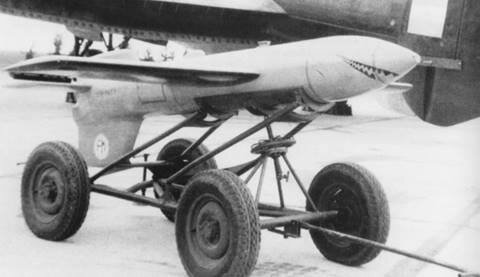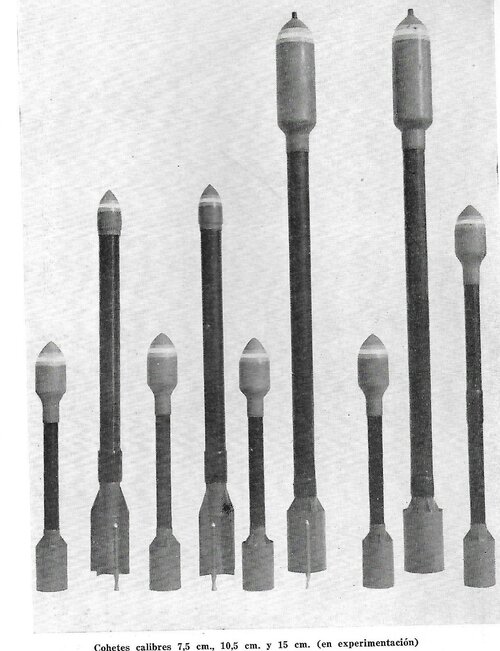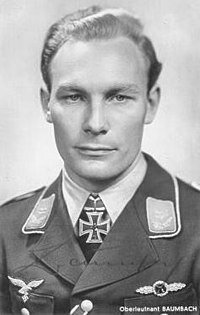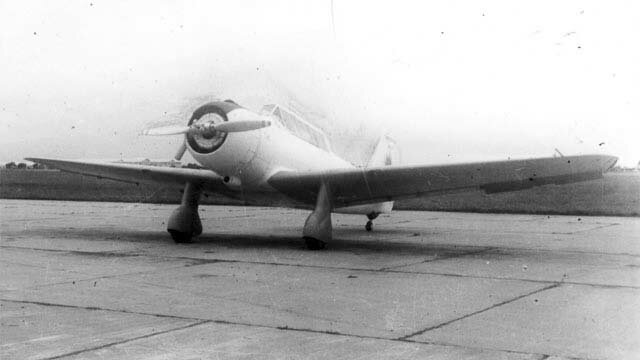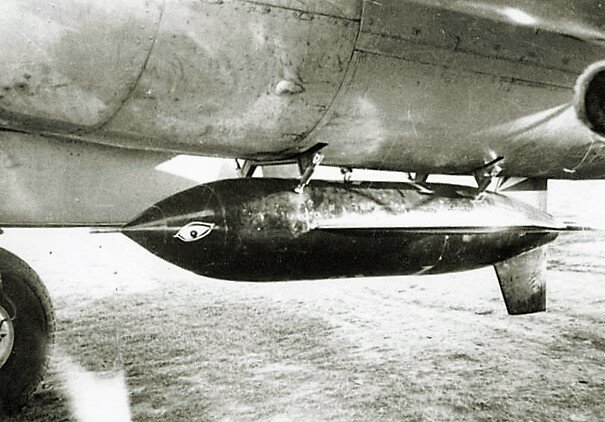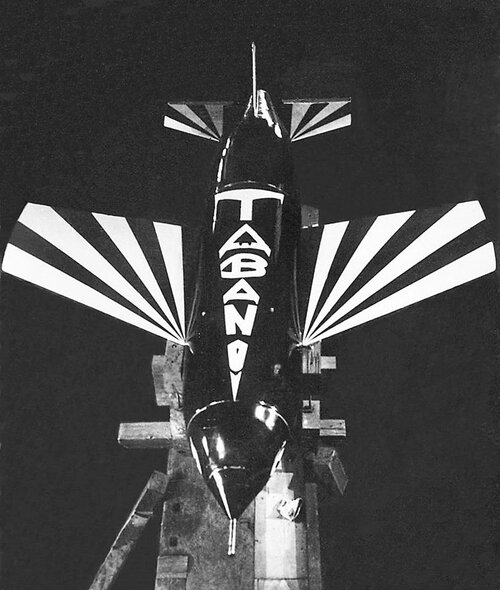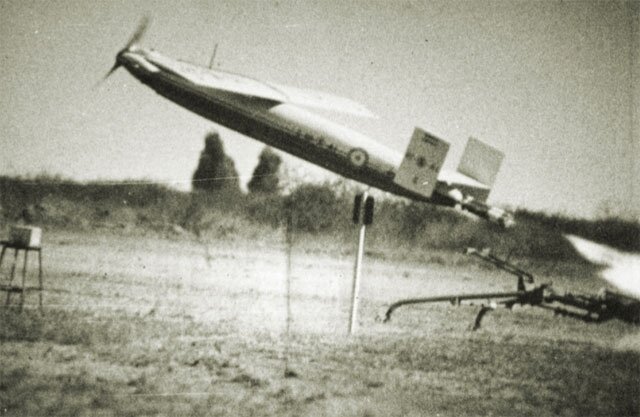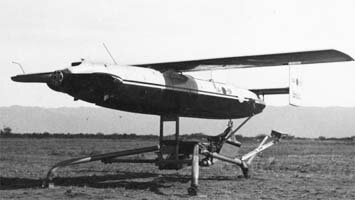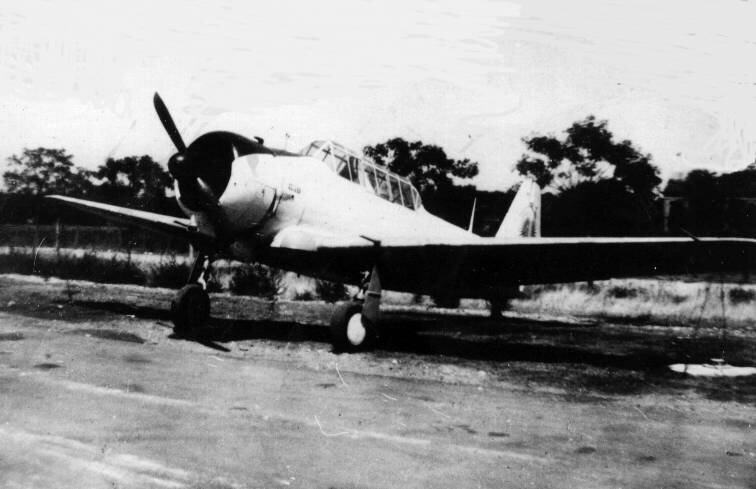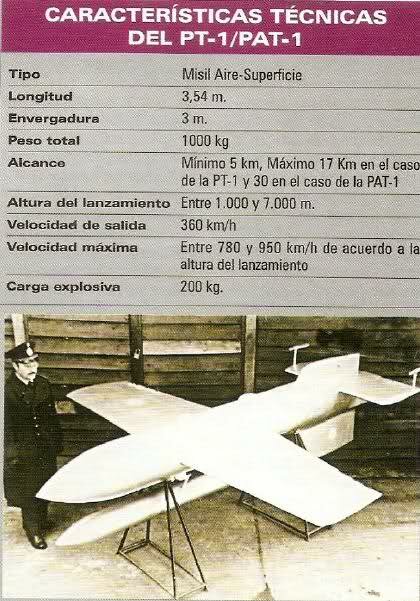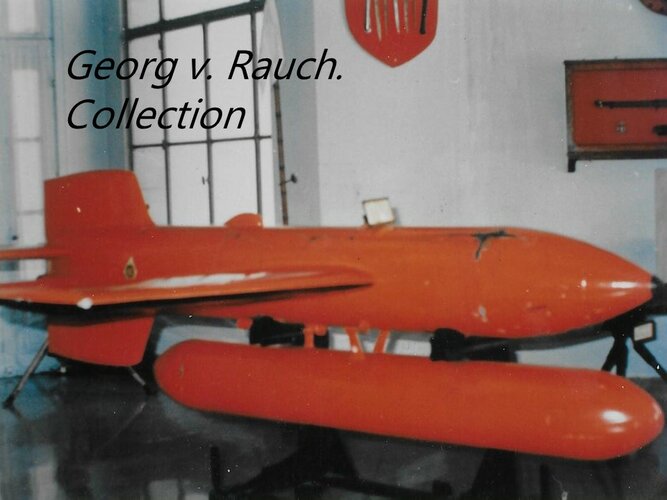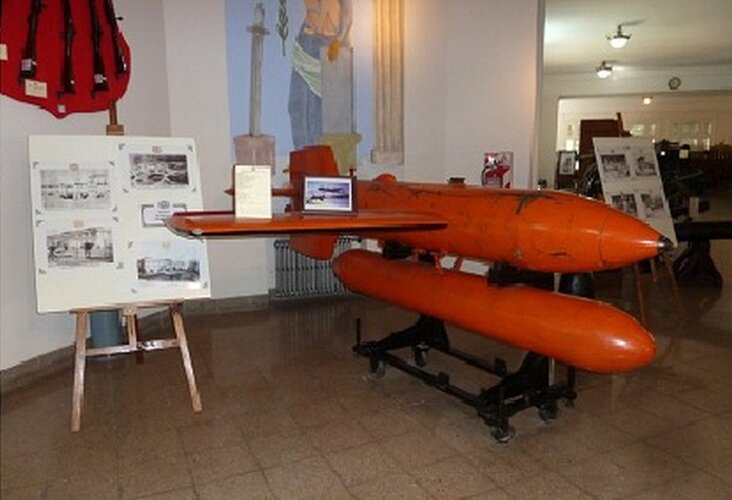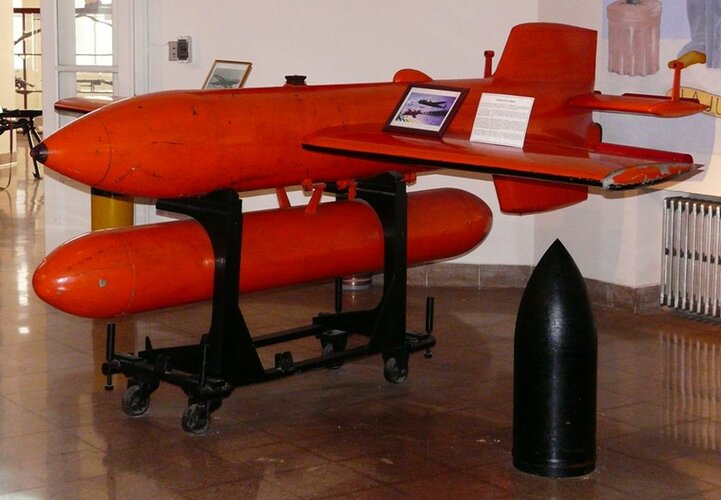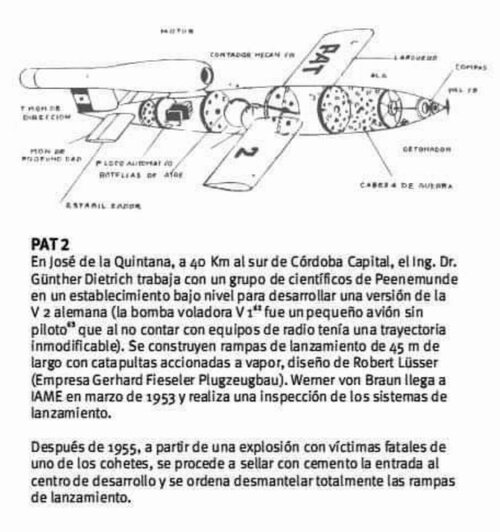You are using an out of date browser. It may not display this or other websites correctly.
You should upgrade or use an alternative browser.
You should upgrade or use an alternative browser.
The PAT-1, an Argentine radio-guided glide bomb.
- Thread starter Badner
- Start date
The project was undertaken by the Dirección de Fabricaciones Militares (DGFM) or Directorate of Military Manufacturing and the IAerotechnical Institute (FMA) of Córdoba, in its Special Projects Division No. III, and under the supervision of Dr. Günther Dietrich, developed various types of propellants such as hydrogen peroxide, oxygen methanol, hydrazine (propergol).
It was carrying an explosive charge of 300 kg with a total weight of 1000 kg including the detachable propellant container. It was transported to the place of combat in a mother plane (heavy bombers AVRO LANCASTER #61 belonging to the Argentine Air Force were used). It was considered that from a height of 1400 m its route would reach 3 km, between 5000 m to 7000 m 18 km; the anchoring system was ventral; To carry out the launch, the carrier aircraft had to make a dive of approximately 500 km/h and make the detachment. The PAT lost about 90 m of elevation before the rocket motor developed its maximum power; Once the propellant is exhausted, the container detaches and glides towards the chosen target at a speed of 850 to 900 km/h; the ignition of the engine lasted 12 s. From the mother plane, the operator carried out the guidance visually by wireless remote control, and by two flares that are lit on the back of the bomb.
Specifications
The PTA-1:: rocket-propelled air-to-ground bomb; 440 kg thrust rocket motor power plant; ignition duration 12 s; maximum speed 900 km/h; wingspan 3 m; length 3.60 m; fuselage diameter 0.48 m;
It was carrying an explosive charge of 300 kg with a total weight of 1000 kg including the detachable propellant container. It was transported to the place of combat in a mother plane (heavy bombers AVRO LANCASTER #61 belonging to the Argentine Air Force were used). It was considered that from a height of 1400 m its route would reach 3 km, between 5000 m to 7000 m 18 km; the anchoring system was ventral; To carry out the launch, the carrier aircraft had to make a dive of approximately 500 km/h and make the detachment. The PAT lost about 90 m of elevation before the rocket motor developed its maximum power; Once the propellant is exhausted, the container detaches and glides towards the chosen target at a speed of 850 to 900 km/h; the ignition of the engine lasted 12 s. From the mother plane, the operator carried out the guidance visually by wireless remote control, and by two flares that are lit on the back of the bomb.
Specifications
The PTA-1:: rocket-propelled air-to-ground bomb; 440 kg thrust rocket motor power plant; ignition duration 12 s; maximum speed 900 km/h; wingspan 3 m; length 3.60 m; fuselage diameter 0.48 m;
Yes, they were similar, but not identical. However, the HS 293 had a mini-TV-camera for guidance, the PTA-A1 did not. As far as the Avro Lancaster Mk.1 employed to test the PTA-1
B-036, serial number 1455, ex RAF PA315, acquired by the Argentine Air Force, equipped in the 1st Bombing Regiment on 03/18/1949, assigned to the Escuela Militar de Aviacion (EMA, or Military Aviation School) in August 1949. During 1950 it was transferred to Area Material at Río IV for experiments with the PAT-1 missile, since 03/13/1951 written off in an accident in the Río de La Plata, off the coast of Quilmes October 20, 1953, when due to engine failure it crashed off Berazategui, in the River Plate. Aside from the crew, the pilot, Oberst (Colonel) Werner Baumbach, former Luftwaffe General oof Bombers, and commander of commander of the secret bomber wing Kampfgeschwader 200 (KG 200) and dipl.ing. Karl Heinrich. designer of the glider bomb.
B-037, s/n 1456, ex RAF PA344, by the Argentine Air Force, taken on strength by Regimiento 1 de Bombardeo)1st Bombing Regiment) on August 2, 1949.Formed part of 2nd. Bombing Group on 13 March 1951. Employed in experiments with the PTA Destroyed by rebel aircraft during the Liberating Revolution, 18 Sept.1955, reportedly carrying a PTA-1 glide bomb.
General der Kampfflieger Werner Baumbach
B-036, serial number 1455, ex RAF PA315, acquired by the Argentine Air Force, equipped in the 1st Bombing Regiment on 03/18/1949, assigned to the Escuela Militar de Aviacion (EMA, or Military Aviation School) in August 1949. During 1950 it was transferred to Area Material at Río IV for experiments with the PAT-1 missile, since 03/13/1951 written off in an accident in the Río de La Plata, off the coast of Quilmes October 20, 1953, when due to engine failure it crashed off Berazategui, in the River Plate. Aside from the crew, the pilot, Oberst (Colonel) Werner Baumbach, former Luftwaffe General oof Bombers, and commander of commander of the secret bomber wing Kampfgeschwader 200 (KG 200) and dipl.ing. Karl Heinrich. designer of the glider bomb.
B-037, s/n 1456, ex RAF PA344, by the Argentine Air Force, taken on strength by Regimiento 1 de Bombardeo)1st Bombing Regiment) on August 2, 1949.Formed part of 2nd. Bombing Group on 13 March 1951. Employed in experiments with the PTA Destroyed by rebel aircraft during the Liberating Revolution, 18 Sept.1955, reportedly carrying a PTA-1 glide bomb.
General der Kampfflieger Werner Baumbach
Attachments
klem
I really should change my personal text
- Joined
- 7 March 2015
- Messages
- 618
- Reaction score
- 1,247
It is always interesting to enrich a subject on SPF and in this sense also see these links. (Https://www.secretprojects.co.uk/threads/argentinian-unbuilt-projects.211/page-6#pos- 398906)-(https://www.secretProjects.co.uk/threatine-missile-projects.33307/#pos-382773).
Thanks! there is some wheat among a lot, a lot of chaff, The one redeeming feature is that articles by Ferreti (whom I met in Córdoba in the 1990s) and Giro on the two decades of (aircraft) production at the Fábrica Militar de Aviones.(June 1962) At the time,the remains of an Aé.M.O.1 had appeared, and my friend Pancho San Marín and Ferreti they were hoping fund would be available to restore this rare aircraft.
The claim that the Indian HF 24 Marut was developed in the Argentine by Kur Tank is nonsense. A c cording to his offical biography (Design for Flight, by Heinz Conradis, who accompanied Tank to the Argentine) by he early 1950s, the Peron regime was in severe financial straits, and aircraft production virtually ceased, except for a few gliders and 2-3 prototypes. Tank began looking for employment oveseas, as his once generous salary was reduced by the constant devaluation of the peso, and in 1954 he traveled to India, in search for greener pastures. His contract would not be renewed, as he had lost much credit with the fatal accidents which involved the 2nd. and 3rd. prototypes of the IA 33 Pulqui II, and mark the ascendancy of Reinmar Horten, designer which Tank hated, and due to his influence in nazi circles in Germany, kept relegated to a secondary role. This campaign against Horten continued in the Argentine, hence when Tank's prestige declined, Horten was given a green light to proceed on his I.A. 37 supersonic fighter and the I.A. 38 flying wing.The 1955 revolution found him in that country, and as soon as Peron was overthrown, he returned to the Argentine and begged to be released from his contract (which was not destined to be renewed, as the crash of the fir. The provisional government that succeeded Peron found no aluminum stocks and the former FMA (which was designated as IAME (or Industrias Aeronáuticas y Mecánicas del Estado) and only two out of 4 Rolls-Royce engines acquired 1948-49.
As far as the HF Marut, design work began in 1956, with Kurt Tank as lead designer. The Project Engineer from HAL was George William Benjami. The first prototype made its maiden flight on June 24, 1961. Production began in 1967, but the aircraft proved a total failure.
Now, as far as the fixed landing gear I.A.é 22 : (see my earlier post)
What a pity. That cuts off quite a few lines of research that I had been developing.
I was hoping to find designs or prototypes, like this DL variant offered to the Navy
Actually, the aircraft in question here was I.A.é 22 s/n 746, which as remarked earlier, was experimentally fitted with a fixed undercarriage, to facilitate the transition to the retractable undercarriage production model, for pilots which had been trained on the North American NA 16. The Navy actually evaluated the I.Aé 22, for a year, was pleased with the aircraft, and placed an initial order for 10 of these trainers. However, the Instituto Aerotécnico (the former FMA, and future IAME) could not guarantee delivery dates, and instead the Aviación Naval obtained an initial batch of 60 AT-6Bs/SNJ-4s Somewhere in y files I have a pic of the aircraft actually evaluated by the Navy, will look for it...
The claim that the Indian HF 24 Marut was developed in the Argentine by Kur Tank is nonsense. A c cording to his offical biography (Design for Flight, by Heinz Conradis, who accompanied Tank to the Argentine) by he early 1950s, the Peron regime was in severe financial straits, and aircraft production virtually ceased, except for a few gliders and 2-3 prototypes. Tank began looking for employment oveseas, as his once generous salary was reduced by the constant devaluation of the peso, and in 1954 he traveled to India, in search for greener pastures. His contract would not be renewed, as he had lost much credit with the fatal accidents which involved the 2nd. and 3rd. prototypes of the IA 33 Pulqui II, and mark the ascendancy of Reinmar Horten, designer which Tank hated, and due to his influence in nazi circles in Germany, kept relegated to a secondary role. This campaign against Horten continued in the Argentine, hence when Tank's prestige declined, Horten was given a green light to proceed on his I.A. 37 supersonic fighter and the I.A. 38 flying wing.The 1955 revolution found him in that country, and as soon as Peron was overthrown, he returned to the Argentine and begged to be released from his contract (which was not destined to be renewed, as the crash of the fir. The provisional government that succeeded Peron found no aluminum stocks and the former FMA (which was designated as IAME (or Industrias Aeronáuticas y Mecánicas del Estado) and only two out of 4 Rolls-Royce engines acquired 1948-49.
As far as the HF Marut, design work began in 1956, with Kurt Tank as lead designer. The Project Engineer from HAL was George William Benjami. The first prototype made its maiden flight on June 24, 1961. Production began in 1967, but the aircraft proved a total failure.
Now, as far as the fixed landing gear I.A.é 22 : (see my earlier post)
What a pity. That cuts off quite a few lines of research that I had been developing.
I was hoping to find designs or prototypes, like this DL variant offered to the Navy
Actually, the aircraft in question here was I.A.é 22 s/n 746, which as remarked earlier, was experimentally fitted with a fixed undercarriage, to facilitate the transition to the retractable undercarriage production model, for pilots which had been trained on the North American NA 16. The Navy actually evaluated the I.Aé 22, for a year, was pleased with the aircraft, and placed an initial order for 10 of these trainers. However, the Instituto Aerotécnico (the former FMA, and future IAME) could not guarantee delivery dates, and instead the Aviación Naval obtained an initial batch of 60 AT-6Bs/SNJ-4s Somewhere in y files I have a pic of the aircraft actually evaluated by the Navy, will look for it...
Attachments
Last edited:
Erdosain
ACCESS: Secret
- Joined
- 10 March 2020
- Messages
- 426
- Reaction score
- 1,696
The name of the glide bomb was PAT-1, not PTA-1.
There is already a specific topic about the projects and designs of Argentine Missile Projects
carried out in the Argentine Republic in the postwar period
You have to use the forum search engine:
Argentine Missile Projects
There is already a specific topic about the projects and designs of Argentine Missile Projects
carried out in the Argentine Republic in the postwar period
You have to use the forum search engine:
Argentine Missile Projects
Thanks for the reference. I visited the Colegio Militar de la Nación several times, the last in 2005 .iIn fact and old and dear friend is a history professor (emeritus) of that institution. and I photographed that surviving PAT.1. Regarding that book by Pancho San Marín, he gave me a copy back in 1997, and acknowledged my own contributions to that work. My scanner ins on the fritz, as I can only access photos in my files, but not scan new ones. A Technician is scheduled to arrive next week, and I'll pos the relevant pages. Also found other files missing, namely the 175 photos originally planned for my book on the FMA, and others obtained in the DEHN (Departamento de Estudios Históricos Navales) and sundry Spanish Civil War Photos l considered lost forever. By the way, eyewitness's statements are contradictory., according to Pancho San Martín 10 PAT-1 were built, while a German technician I interviewed in Princeton said there were between 5-10.
Attachments
Last edited:
Also found other files missing, namely the 175 (ACTUALLY 245) photos originally planned for my book on the FMA, and others obtained in the DEHN (Departamento de Estudios Históricos Navales) .. What appears to be missing is the book by Pancho San Martín....
- Joined
- 3 September 2006
- Messages
- 1,387
- Reaction score
- 1,214
Moderators, it may be better to move the missile-related post to the existing thread in Missile projects?
or move the whole thread there?
or move the whole thread there?
Erdosain
ACCESS: Secret
- Joined
- 10 March 2020
- Messages
- 426
- Reaction score
- 1,696
The name of the glide bomb was PAT-1, not PTA-1.
There is already a specific topic about the projects and designs of Argentine Missile Projects
carried out in the Argentine Republic in the postwar period
You have to use the forum search engine:
Argentine Missile Projects
Moderators, it may be better to move the missile-related post to the existing thread in Missile projects?
or move the whole thread there?
Yes, I am of the same opinion.
Mr @overscan (PaulMM) , could both themes be merged?
Erdosain
ACCESS: Secret
- Joined
- 10 March 2020
- Messages
- 426
- Reaction score
- 1,696
ASM PAT-1 and PAT-2.
PAT-1(Proyectil Argentino Teledirigido)was an anti ship missile, based on Henschel Hs-293

PAT-2 was a cruise missile based on Germany V-1 missile .


PAT-1(Proyectil Argentino Teledirigido)was an anti ship missile, based on Henschel Hs-293
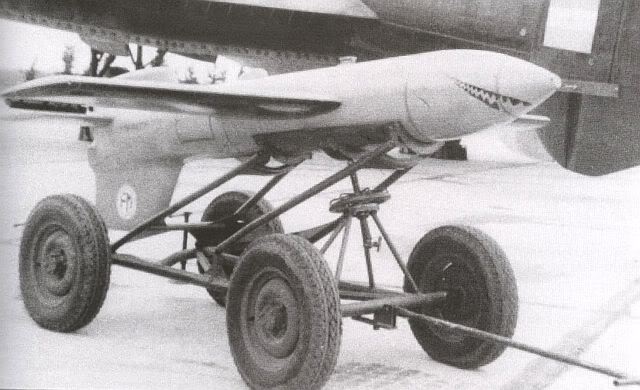
PAT-2 was a cruise missile based on Germany V-1 missile .
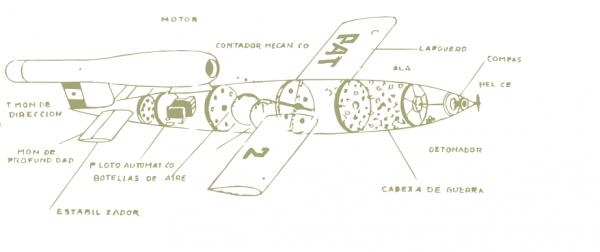
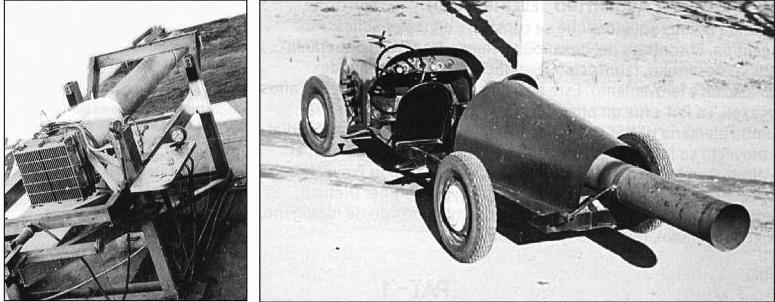
Erdosain
ACCESS: Secret
- Joined
- 10 March 2020
- Messages
- 426
- Reaction score
- 1,696
Avro Lancaster of Fuerza Aérea Argentina with PAT-1 Missile

Erdosain
ACCESS: Secret
- Joined
- 10 March 2020
- Messages
- 426
- Reaction score
- 1,696
Erdosain
ACCESS: Secret
- Joined
- 10 March 2020
- Messages
- 426
- Reaction score
- 1,696
Proyectiles teledirigidos en Argentina - parte 1
By Hernan Longoni (This article was written in 2001for the web Arqueologia Aeronautica Argentina and Reporte Aereo Mundial).
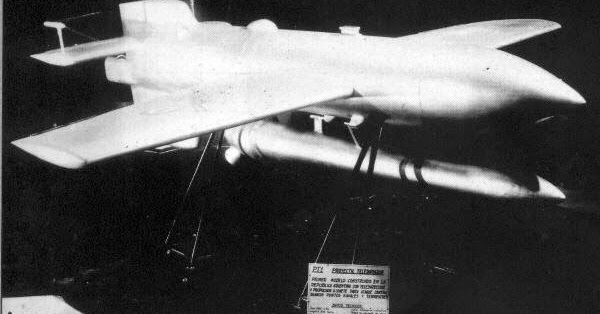
Proyectiles teledirigidos en Argentina - parte 1
Por Hernan Longoni (nota escrita en el año 2001 para Arqueologia Aeronautica Argentina y Reporte Aereo Mundial). El PT1. nótese en el c...
Dilandu
I'm dissatisfied, which means, I exist.
Operational Hs.293 did not have any TV cameras. There were some experiments with TV-equipped bombs in Germany, but nothing ever remotely comparable with USAAF's GB-4 TV-guided bomb (and let's be frank, GB-4 wasn't exactly very efficient either, despite being operationally used several times)Yes, they were similar, but not identical. However, the HS 293 had a mini-TV-camera for guidance, the PTA-A1 did
The PAT-1 have exactly the same guidance as Hs.193; visual tracking with the help of flares, and manual line-of-sight command system.
- Joined
- 2 January 2006
- Messages
- 977
- Reaction score
- 1,656
Similar threads
-
A DFS Automatically Controlled Glide Bomb.1943
- Started by klem
- Replies: 3
-
-
Ground Launched Small Diameter Bomb (GLSDB)
- Started by Triton
- Replies: 157
-
Henschel Hs 293 developments and projects
- Started by Jemiba
- Replies: 16
-
Condor II and sister Argentine-Iraq-Egypt projects
- Started by Gaafar
- Replies: 17

